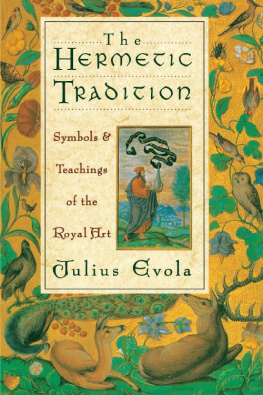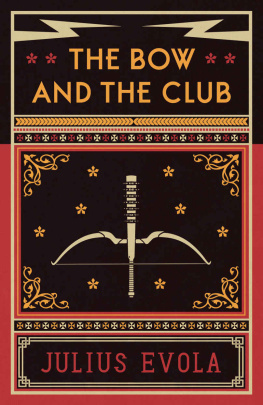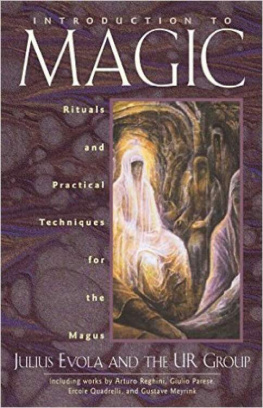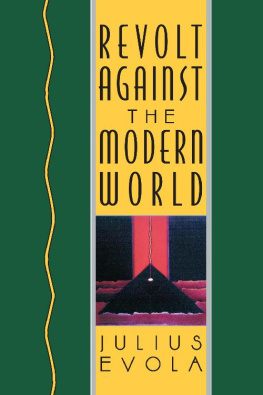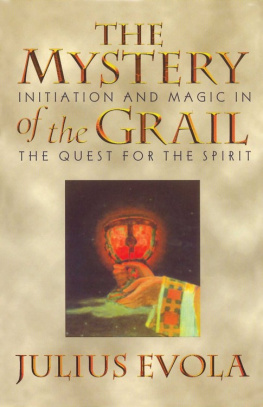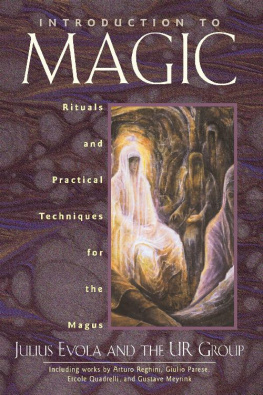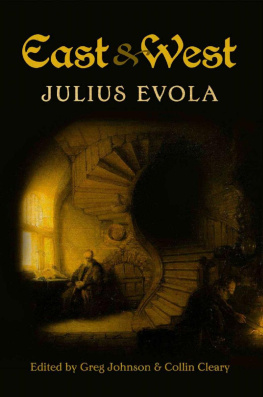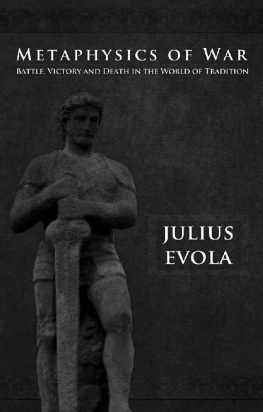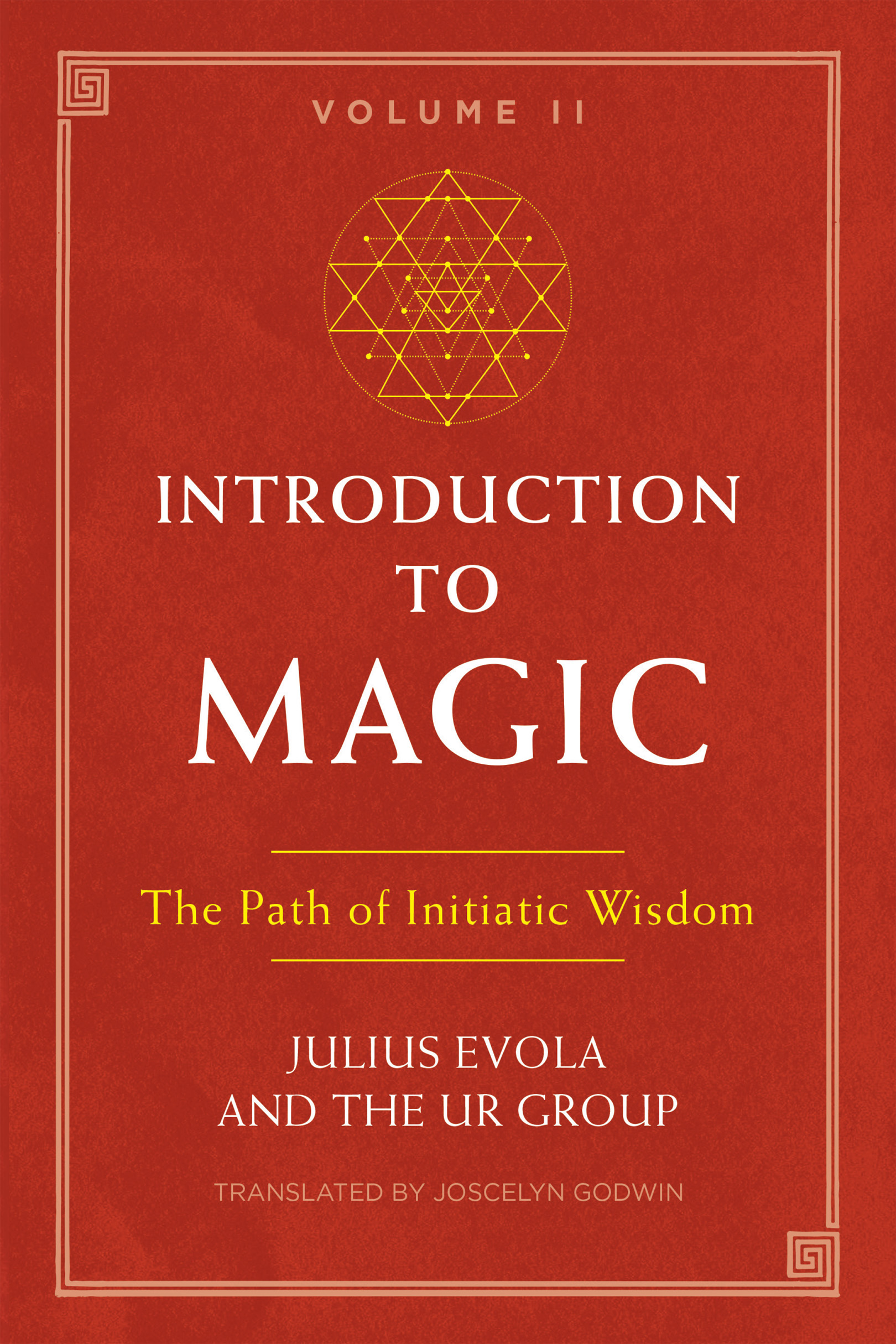

PRAISE FOR THE WORKS OF JULIUS EVOLA

A dazzling and interesting, but very dangerous, author...
HERMANN HESSE, AUTHOR OF SIDDHARTHA
One of the most difficult and ambiguous figures in modern esotericism.
RICHARD SMOLEY, AUTHOR OF THE DEAL: A GUIDE TO RADICAL AND COMPLETE FORGIVENESS
Eros and the Mysteries of Love invokes the rich sexual symbolism of religious myths and mysteries throughout history, from the I Ching to the Kabbalah, to illustrate the redemptive power of the sexual act.
LOS ANGELES TIMES
Introduction to Magic, vol. I, should be standard reading for any serious academic or practical student of occultism Experienced occultists will welcome it as a breath of fresh air and a journey into little discussed territories.
MARK STAVISH, AUTHOR OF EGREGORES AND FOUNDER OF THE INSTITUTE FOR HERMETIC STUDIES
The collection of essays in Introduction to Magic, vol. I cover the practical, the theoretical, and the unclassifiable, such as the Mithraic Ritual of the Great Magical Papyrus of Paris, the only ritual from the ancient Mysteries to have survived intact.
THE WATKINS REVIEW
Revolt Against the Modern World is destined to remain an essential work and frame-of-reference for anyone seriously involved in native European spirituality.
MICHAEL MOYNIHAN, COAUTHOR OF LORDS OF CHAOS
Disgusted by the cruelty and artificiality of communism, scorning the dogmatic, self-centered fascism of his age, Evola looks beyond man-made systems inMen Among the Ruins to the eternal principles in creation and human society. The truth, as he sees it, is so totally at odds with the present way of thinking that it shocks the modern mind. Evola was no politician, trying to make the best of things, but an idealist, uncompromising in the pursuit of the best itself.
JOHN MICHELL, AUTHOR OF THE DIMENSIONS OF PARADISE
Men Among the Ruins is Julius Evolas most notorious work: an unsparing indictment of modern society and politics. This book is not a work for complacent, self-satisfied minds... it is a shocking and humbling text that will be either loved or hated. Evolas enemies cannot refute him; they can only ignore him. They do so at their peril.
GLENN A. MAGEE, AUTHOR OF
HEGEL AND THE HERMETIC TRADITION
In Ride the Tiger Evola shows, unintentionally but with passion, why European Tradition may not be able to match East Asia in riding the tiger in todays world. It lacks a spirituality for todays mundane world, tempered by the harsh realism of Daoism and the practical disciplines of Confucianism.
NEW DAWN MAGAZINE
Evola... had a clarity of mind and a gift for explaining tremendously difficult concepts in nonacademic language His descriptions of subtle states and the practices that lead to them are as lucid as these difficult subjects allow.
GNOSIS: A JOURNAL OF THE WESTERN INNER TRADITIONS
FOREWORD
The Magical Gruppo di UR in Its Historical and Esoteric Context
By Hans Thomas Hakl
A t last the second volume of writings by the Gruppo di URor UR Group, as we shall henceforth refer to ithas been completely translated. The first volume immediately met with great interest, because of the high quality of its contents, but at the same time it raised a whole series of questions: From what tradition did the UR Group derive its extraordinary knowledge? What was its goal? Who were the leading figures, and what is known about them? Why did the group only last for three years? Are (or were) there organizations that descended from it, perhaps still working to this day?
Professor Renato del Ponte, in his preface to the first volume, has already described the essentials of the group, and provided many answers that we will take for granted here. His work was the very first to shed a brighter light on the background of the UR Group.
His investigation, however, focused only on the UR Group itself, not on the traditional strands preceding it or on the post-1929 groups that claimed a connection to it. Therefore, we will specifically address such matters here. Since these strands and groups span several centuries, we can only provide an overview of them, like a series of snapshots. But there is quite a comprehensive literature for readers of Italian, if not always easily accessible, which treats the various aspects of this history in detail. The only exception concerns the post-1929 groups, about which little has been published up to now.
PREHISTORY
Here we will concentrate on the Italian component, leaving aside the thread that goes back to Rudolf Steiners Anthroposophy. Much has been written on the history of Anthroposophy and Theosophy, which has nothing directly to do with UR. Nor will we treat the era before the eighteenth century, since specific derivations from Pythagoras, for example via Neoplatonism and the Renaissance, are practically impossible to pin down historically. This does not mean, however, that we deny the esoteric and/or intellectual connections that reach back to these earlier timesquite the contrary.
Instead we will begin with a central figure, who, together with the dubiously renowned Cagliostro (Giuseppe Balsamo, 1743/491795), was presumably the modern starting point of magical-alchemical efforts in Italy. This is Raimondo di Sangro, Prince of San Severo and Duke of Torremaggiore (17101771), a multifaceted personality around whom countless legends swirled, and continue to do so. He was the first regular Grand Master of Neapolitan Freemasonry, and united all the local lodges under his leadership. He was intensively occupied with magical and alchemical experiments, which finally led to his excommunication by the pope.
The enigmatic nature of Raimondo di Sangros life continued right up to his death, because he died under mysterious circumstances, probably from poisoning, reputedly caused by his own alchemical experiments.
The so-called Egyptian Rites later enjoyed wide distribution, right up to the most well-known modern magical order, the Hermetic Order of the Golden Dawn; this leads one to suspect a common descent from the Gold and Rose Cross. There are even visible influences in the Egyptian lodge of Anthroposophical leanings in Hamburg, called Zu den drei Rosen an der Elbe (At the three roses on the river Elbe). Theosophy, too, had an Egyptian Rite founded by Charles Leadbeater; see Introvigne, La sfida magica, 11015, and also Carlo Gentile, Il mistero di Cagliostro e il sistema egiziano (Foggia: Bastogi, 1980), and Serge Caillet, Arcanes & Rituels de la Maonnerie Egyptienne (Paris: Trdaniel, 1994).
In 1983, after a long search, Professor Clara Miccinelli discovered in a house in Naples a locked chest containing Raimondo di Sangros Testament, along with a medallion of him; it also contained several writings, including prophecies, and objects that he had owned. It can still be visited and is today one of the most important museums of Naples, containing many artistic treasures.
From Naples, a line of tradition leads to France, settling in the purely Masonic Egyptian Rite of Misraim and Memphis. also to the advocate Giustiniano Lebano and to Pasquale de Servis. Giustiniano Lebano (18321909) was an officer in regular Masonry (the Grand Orient), a member of the Egyptian Rites united under the Italian revolutionary hero Garibaldi, and was also active in the Theosophical Society. He received occultists from all over Europe, and collected a comprehensive library.
Next page

